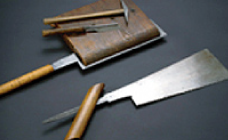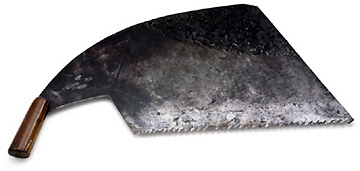Saw [nokogiri]
Saw
Saw

The appearance of saws was old, and it seems that primitive things were beginning to be used in the Paleolithic age. However, it may have begun to be used as woodworking tools only after the appearance of metal saws. Bronze saws were already used in Egypt and China's Yin Zhou era, and especially in Egypt, around the 14th century BC, there were almost no different things from the present one. Iron saws began to be used in the Roman era in Europe and in the Hata and Han eras in China. This was given with sloping and clams of saw teeth that were not seen in bronze saws, and it seems that the processing capacity was greatly improved.
In Japan, stone axes were the main tools of processing. In the Yayoi period, iron technology was introduced, and iron Axe began to be used, but the appearance of iron saws was quite late in the early Kofun period. However, the saws in the early Kofun period were simple with bare teeth carved on strip-shaped iron plates, and there is a question mark whether they were used for construction production. In the latter half of the Kofun period, many of them have stems for wearing wooden patterns, and progress has been seen as woodworking tools, such as those with Gagarime and clams and narcissors on saw teeth.

A saw excavated from the tumulus (5th century, restored, excavated from Kinzoyama Tumulus in Okayama Prefecture)
The number of saws buried in tumuli during the Kofun period decreased as the construction of tumuli decreased, and there are not many existing from Asuka and Nara period to the Kamakura period. Many of the existing saws have a unique shape, and there are many unclear points, but it is thought that they were larger and almost completed as woodworking tools compared to the previous era. Among them, Horyuji Temple's treasure saw is the oldest sermon, and although the saw body is partially damaged, it is a valuable thing that retains the wooden pattern completely.
In addition, the oldest existing wooden building that leaves traces of saws is the building of Horyuji Temple. According to a survey at the time of repair, saw marks (lateral grinding) have been confirmed on the cutting surface of Oto.

Saw excavated from around the 8th century (actual measurement map, Shirakura Shimohara, Gunma Prefecture, Amabiki Mukaihara Site)
In the Middle Ages, it can be seen from picture scrolls that a "leaf-shaped saw" with a curved blade of saw teeth and a pointed tip was used. It is thought that this type of saw was used until the middle of the Edo period, but there are few excavations.
Looking at sawmills, there were no vertical saws in Japan until the middle of the Muromachi period, and sawmilling was performed using a chisel cutting method, but in the Middle Ages, two-man sawing vertical saw "Oga" was introduced from the continent. The sawmilling capacity improved dramatically and had a significant impact on building production. This saw will disappear in a short period of time in Japan, but it was changed into one-man ground "Maebiki-oga Wide Blade Ripsaw" and "Gagari" for small split, and it was the mainstream of sawmilling until it was replaced by machine sawmilling in the middle of the Meiji era. In particular, Maebiki-oga Wide Blade Ripsaw with a wide saw body is unique to Japan.

2-person saw sawmill saw "Dai saw" (restored product)

One-man sawmill saw "Maebiki-oga Wide Blade Ripsaw" (around Meiji era, Oomi Koga)
In the Edo period, saws were subdivided by application due to improved tool productivity and differentiation of functions, and it is thought that many forms of traditional saw seen today were available. It was also around this time that saw production areas such as Aizu and Miki occurred. In the Meiji era, double-edge saws as seen today occurred and became widespread.
On the other hand, the mechanization of sawmills, which began in the Meiji era, gradually replaced hand tools, and after the war, carpentry work was mechanized by power tools that developed dramatically, and today the saw as a hand tool has finished its development process. However, it is also true that there are no carpenters looking for good saws in search of the texture and precision brought by hand tools.
(1996: Significantly added to the commentary on the catalog of "Sawless Space" exhibition)
Basic information
Special Exhibition
Permanent exhibition